Expert Video Guide: Best Cooking Oils for Wok and Stir-Fry Techniques
The Complete Video Guide to Cooking Oils for Asian Cuisine: Expert Reviews and Professional Techniques
Master traditional and modern oil selection through expert video analysis, professional Chinese techniques, and scientific smoke point research
Selecting the right cooking oil for Asian cuisine, particularly wok cooking and stir-frying, requires understanding both traditional techniques and modern food science. This comprehensive video guide features expert analysis from professional chefs, food scientists, and authentic Asian cooking authorities to help you choose the optimal oil for your culinary goals.
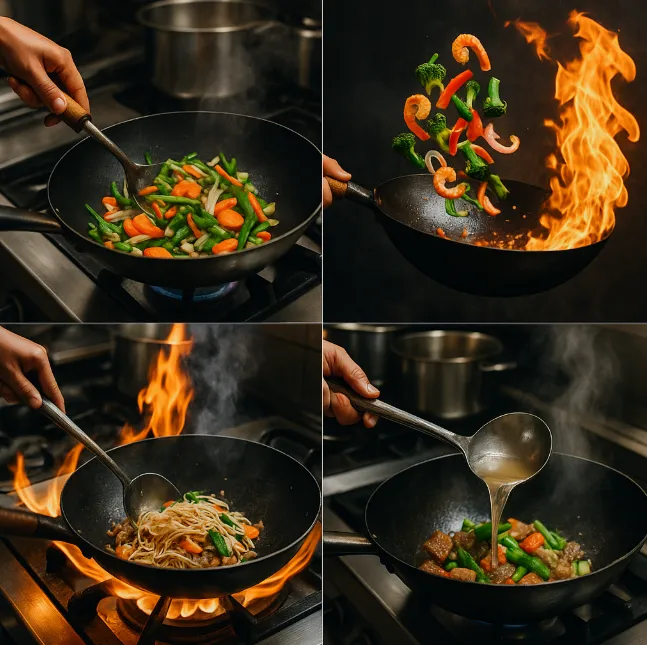
Expert Oil Rankings: Top 10 Oils for Wok Cooking
Understanding oil selection criteria forms the foundation of successful Asian cooking. Professional analysis reveals four critical factors that determine optimal oil performance in high-heat applications.
{{< youtube SeuBSQjb2BQ 45 "number one canola oil and number two grapeseed oil number three refined olive oil number four avocado oil" >}}
According to this systematic analysis, the top oil recommendations prioritize smoke point performance, nutritional composition, flavor characteristics, and cost effectiveness. Cultural Note: This ranking reflects modern understanding of oil chemistry applied to traditional Asian cooking methods, building on the historical foundation explored in our complete wok cooking series.
Professional Oil Selection Criteria
The video analysis establishes four essential evaluation factors:
1. Smoke Point Performance Smoke point represents the critical temperature threshold where oil molecules begin breaking down. For proper wok stir-frying, oils must withstand temperatures of 400-500°F to enable Maillard reactions while maintaining molecular integrity.
2. Fatty Acid Composition Oil stability under heat depends on molecular structure. Saturated and monounsaturated fatty acids resist breakdown better than polyunsaturated alternatives during high-temperature cooking applications.
3. Flavor Profile Impact Neutral-flavored oils allow traditional Asian seasonings and aromatics to predominate, while strongly flavored oils can overwhelm delicate ingredient balances in authentic preparations.
4. Economic Considerations Premium oil selection balances performance characteristics with practical cost considerations, particularly important for regular home cooking applications.
Scientific Analysis: Smoke Points and Heat Transfer
Understanding the science behind oil performance at high temperatures provides crucial insight for optimal Asian cooking results.
{{< youtube atgZekV_oPo 120 "An oil smoke point is the temperature at which macro-molecules in the oil start to break down" >}}
This scientific analysis explains why smoke point considerations matter beyond simple temperature thresholds. When oils exceed their smoke point, triglyceride molecules decompose into free fatty acids and glycerol, producing harmful compounds and bitter flavors that compromise food quality.
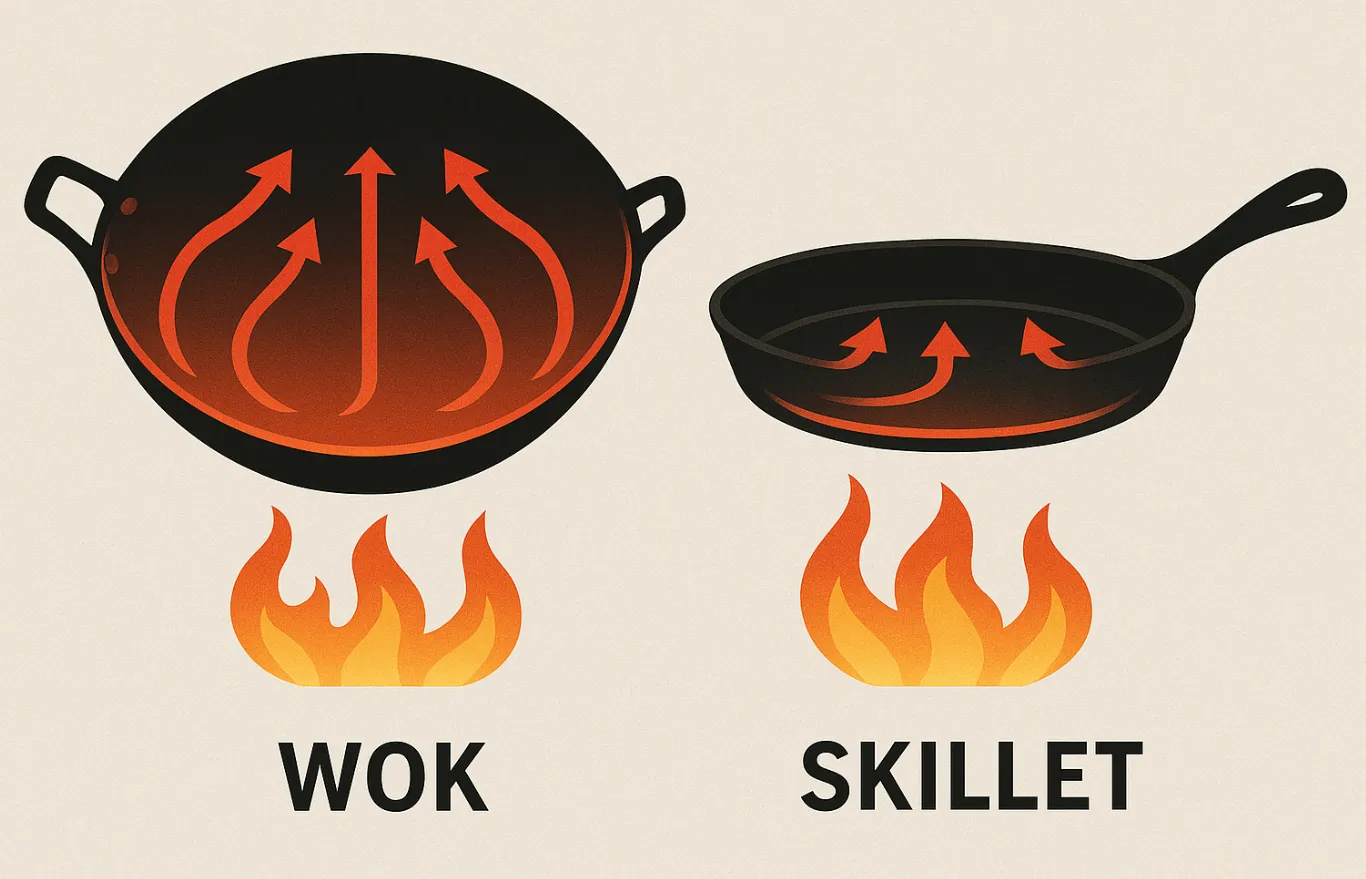
Complete Smoke Point Reference Chart
| Oil Type | Smoke Point (°F) | Smoke Point (°C) | Best Applications |
|---|---|---|---|
| Algae Oil | 485-510 | 252-266 | High-heat stir-frying, wok hei |
| Avocado Oil | 520 | 271 | Extreme heat cooking |
| Peanut Oil | 450 | 232 | Traditional Chinese stir-frying |
| Canola Oil | 400 | 204 | General Asian cooking |
| Grapeseed Oil | 420 | 216 | Light stir-frying |
| Refined Olive Oil | 465 | 241 | Mediterranean-Asian fusion |
| Sesame Oil | 350-410 | 177-210 | Flavoring agent only |
| Vegetable Oil | 400-450 | 204-232 | Budget-friendly option |
Buying Reality: Higher smoke point oils command premium pricing but provide essential performance advantages for authentic Asian cooking techniques requiring sustained high-heat applications.
Professional Chinese Restaurant Techniques
Authentic Chinese cooking employs specific oil preparation methods that distinguish restaurant-quality results from typical home cooking attempts.
{{< youtube WujehK7kYLM 180 "In restaurants before frying, they'll heat their wok til it's super hot, add in some oil, swirl it around" >}}
This demonstration reveals the professional "Longyau" technique (also called "Huaguo" in Mandarin), a restaurant method creating optimal frying surfaces. The technique involves heating the wok to maximum temperature, adding oil, swirling to coat the surface, then draining excess oil to prevent burning while maintaining non-stick properties.
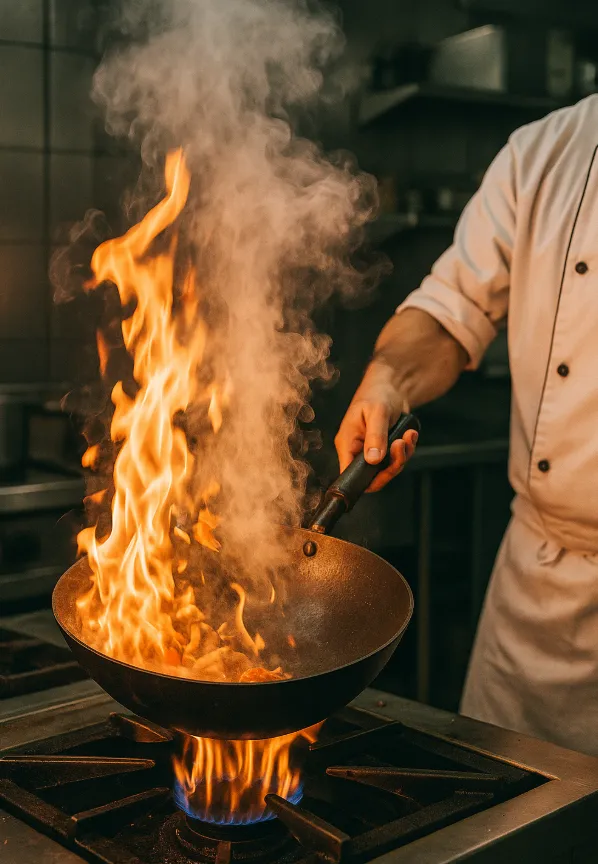
Four Professional Stir-Frying Methods
The demonstration covers four distinct approaches used in professional Chinese kitchens:
1. Ingredient-by-Ingredient Method Sequential cooking ensures each component reaches optimal doneness while maintaining texture and color integrity.
2. No-Wok Alternative Technique Adaptation methods for home cooks using standard skillets while achieving similar results through modified timing and temperature control.
3. One-Pot Street Vendor Style Efficient technique combining all ingredients simultaneously, popular among Chinese street food vendors for speed and convenience.
4. Deep-Frying "Passing Through Oil" Method Restaurant technique producing exceptionally tender meat through brief high-temperature oil immersion before final stir-frying.
Advanced Food Science: Heat Transfer and Oil Behavior
Professional-level understanding of oil behavior during high-heat cooking provides crucial insights for achieving restaurant-quality results at home.
{{< youtube 2KNlXt0u_5o 60 "when you get your wok hot enough to the point that you're going to be properly stir-frying that is going to be well beyond the smoke point" >}}
This analysis from food science authority Kenji López-Alt explains why proper wok technique requires oils capable of performing beyond their stated smoke points. Authentic wok cooking reaches temperatures of 600°F or higher, demanding oils with exceptional thermal stability.
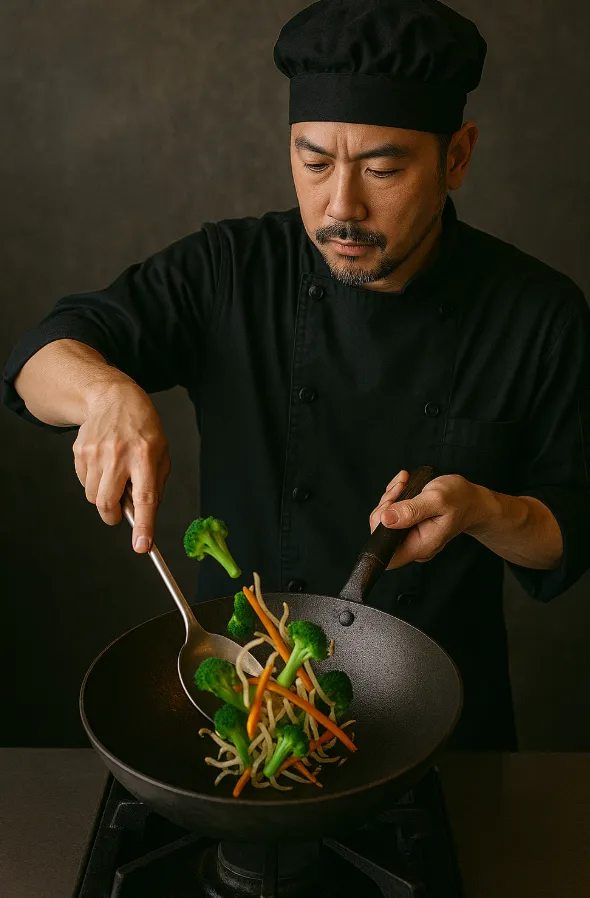
Critical Timing Principles
The demonstration emphasizes three essential timing elements:
1. Oil Addition Timing Add oil immediately before food addition to prevent thermal breakdown and bitter flavor development.
2. Moisture Evaporation Priority Successful stir-frying prioritizes rapid moisture evaporation over direct heat transfer, requiring proper oil temperature maintenance.
3. Small Batch Cooking Home equipment limitations necessitate smaller batch sizes to maintain proper heat levels and prevent steaming effects.
Equipment Integration: Understanding proper wok setup for home kitchens becomes crucial when selecting oils for optimal performance across different heat sources and cooking surfaces.
Modern Innovation: Sustainable High-Performance Oils
Contemporary cooking oil development introduces new options combining traditional performance requirements with modern sustainability concerns.
{{< youtube 2yBRA0uluEM 30 "It's got a subtle, buttery flavor, but it's noticeably clear in color and clean in taste" >}}
Professional adoption of algae oil by acclaimed chefs like Daniel Humm at 11 Madison Park demonstrates serious culinary applications for this sustainable alternative. The three-Michelin-starred establishment's transition to plant-based cuisine while maintaining exceptional standards showcases algae oil's professional viability.
Algae Oil Performance Characteristics
According to the professional analysis featured, algae oil provides several advantages for Asian cooking applications:
Flavor Neutrality: Clean taste profile that doesn't interfere with traditional Asian seasonings and aromatics, unlike some oils that can "detract from the nuances of the food you're preparing."
Versatile Applications: Professional recommendations include frying, salad dressing, smoothie integration, and emulsification applications, demonstrating broad culinary utility.
Sustainability Profile: Environmental advantages include significantly reduced land and water usage compared to traditional oil crops, addressing growing ecological concerns in food production.
Cross-Reference: For comprehensive analysis of algae oil's specific applications in Asian cooking, including detailed smoke point performance and nutritional profiles, see our complete algae oil guide for Asian cuisine.
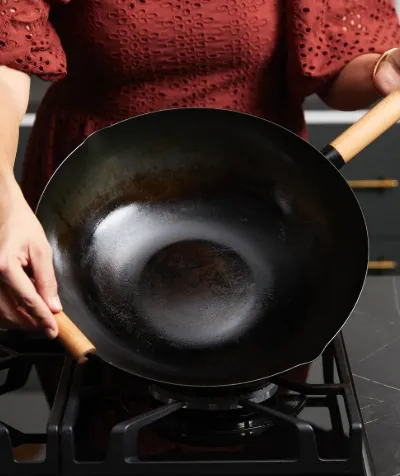
Traditional Oil Preferences by Regional Cuisine
Different Asian culinary traditions demonstrate distinct oil preferences based on historical availability, flavor profiles, and cooking method requirements.
Chinese Cuisine Oil Selection
Traditional Chinese cooking emphasizes neutral-flavored oils that support rather than compete with complex seasoning combinations:
Northern Chinese Preferences: Rapeseed oil and soybean oil dominate due to regional crop availability and economic considerations.
Southern Chinese Applications: Peanut oil predominates in Cantonese cooking for its high smoke point and subtle nutty characteristics that complement seafood preparations.
Sichuan Specialization: Heat-stable oils become essential for intense chili oil preparation and high-temperature dry-frying techniques.
Japanese Culinary Integration
Japanese cooking philosophy emphasizes ingredient purity and subtle flavor enhancement:
Tempura Applications: Light, neutral oils enable proper batter texture development while preserving delicate seafood and vegetable flavors.
Chukanabe Cooking: Japanese-Chinese fusion techniques require oils capable of sustained high-heat performance while maintaining flavor neutrality. This connects directly to our Japanese chukanabe cooking guide for detailed technique analysis.
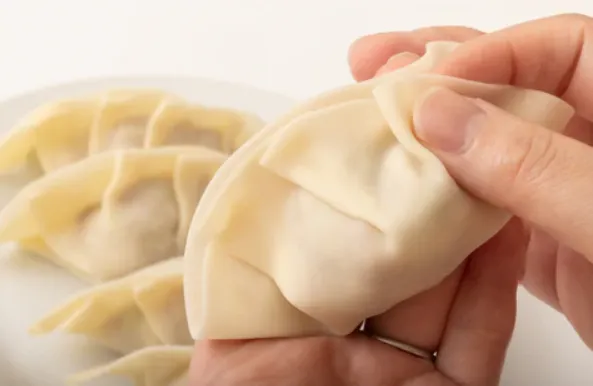
Southeast Asian Considerations
Complex spice profiles in Thai, Vietnamese, and Malaysian cuisines require oils that enhance rather than mask aromatic ingredients:
Thai Stir-Frying: Neutral oils support intense herb and spice combinations without creating competing flavors.
Vietnamese Applications: Light oil profiles complement fresh ingredient emphasis and delicate sauce preparations.
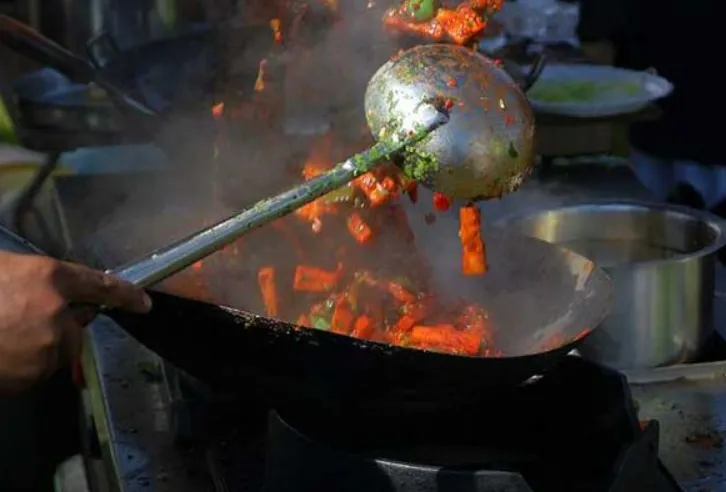
Equipment and Oil Performance Integration
Oil selection works in conjunction with proper equipment setup to achieve optimal Asian cooking results.
Wok Material Considerations: Different wok materials interact uniquely with various oils during seasoning and cooking processes. Our comprehensive wok material guide explores these interactions in detail.
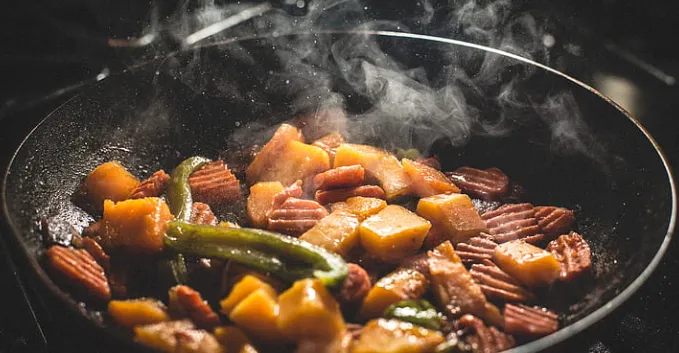
Heat Source Optimization: Home cooking equipment limitations require strategic oil selection to compensate for lower BTU output compared to professional restaurant equipment.
Seasoning Integration: Proper wok seasoning techniques benefit from understanding oil polymerization characteristics, particularly when using high-performance oils like algae oil for both cooking and maintenance applications.
Practical Selection Guidelines
Budget-Conscious Recommendations
Primary Choice: Canola oil provides reliable performance for most Asian cooking applications at reasonable cost.
Traditional Alternative: Peanut oil offers authentic flavor characteristics used in traditional Chinese restaurants, justified for frequent Asian cooking.
Premium Investment: Reserve specialized oils like algae oil for applications requiring maximum performance or when sustainability concerns justify premium pricing.
Performance-Focused Selections
High-Heat Priority: Algae oil, avocado oil, or refined peanut oil for sustained high-temperature cooking requiring wok hei achievement.
Flavor Neutrality: Canola oil, grapeseed oil, or algae oil when preserving delicate ingredient flavors takes priority.
Traditional Authenticity: Peanut oil for recreating restaurant-style Chinese cooking or when traditional flavor characteristics matter.
Storage and Quality Maintenance
Temperature Control: Store oils in cool, dark locations to prevent oxidation and rancidity development.
Container Selection: Dark glass containers provide optimal protection from light exposure that accelerates oil degradation.
Usage Rotation: Use oldest oils first and monitor for off-flavors indicating quality deterioration.
Professional Kitchen Applications
Restaurant and serious home kitchen integration requires understanding optimal oil deployment across different cooking stations and applications.
Wok Station Setup: Dedicate high-performance oils like algae oil or peanut oil for primary stir-frying applications requiring consistent results.
Deep-Frying Considerations: Higher-volume oil applications may justify blending premium oils with cost-effective alternatives to balance performance and economics.
Specialty Preparations: Reserve premium oils for dishes where their unique characteristics provide clear advantages over standard alternatives.
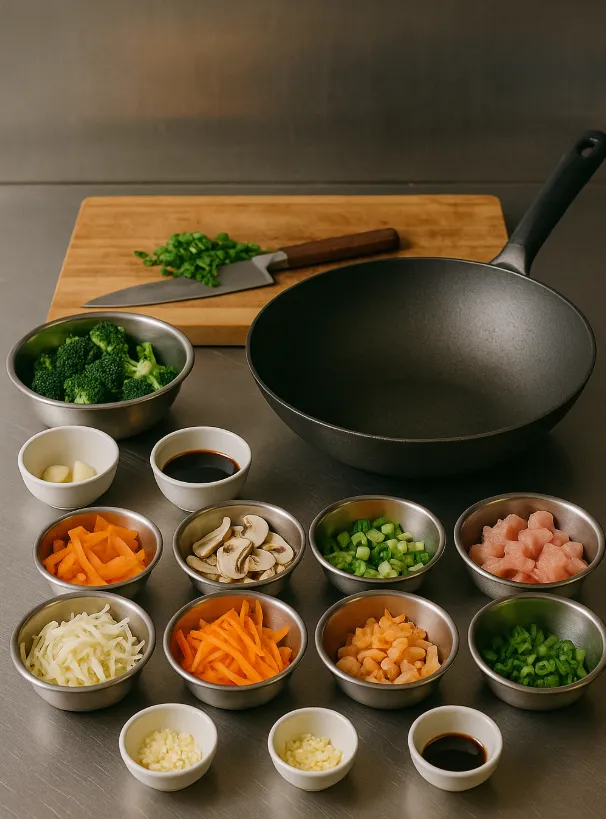
Future Trends and Innovation
Cooking oil development continues evolving to address performance, sustainability, and health considerations relevant to Asian cuisine applications.
Sustainability Focus: Environmental concerns drive innovation in alternative oil sources like algae, reducing agricultural land competition while maintaining cooking performance.
Production Scaling: Manufacturing improvements continue reducing costs for premium oil options, making advanced alternatives more accessible to home cooks.
Performance Enhancement: Ongoing research into oil composition and processing methods aims to improve smoke point characteristics and thermal stability.
Conclusion
Selecting optimal cooking oils for Asian cuisine requires balancing traditional authenticity, modern food science understanding, and practical considerations including cost and availability. The expert video analysis presented demonstrates that no single oil performs optimally across all applications, necessitating strategic selection based on specific cooking methods and desired outcomes.
For traditional Chinese stir-frying, peanut oil provides time-tested performance characteristics that have supported authentic cuisine for generations. Modern alternatives like algae oil offer enhanced performance and sustainability benefits that justify premium pricing for serious practitioners of Asian cooking arts.
The key to success lies in understanding the scientific principles underlying oil performance while respecting the cultural traditions that shaped Asian culinary development. Whether pursuing traditional authenticity or exploring modern innovations, proper oil selection provides the foundation for achieving restaurant-quality results in home kitchens.
Integration Note: This guide complements our existing comprehensive wok cooking series and provides the oil knowledge foundation for advancing your Asian cooking expertise to professional levels.
For detailed technical analysis of algae oil's specific applications in Asian cooking, including molecular composition and sustainability metrics, refer to our comprehensive algae oil guide.
Comments
Post a Comment